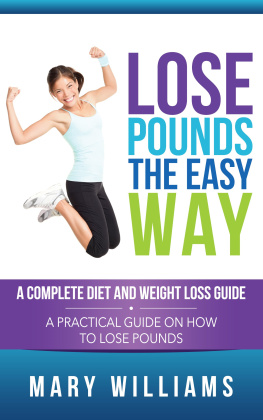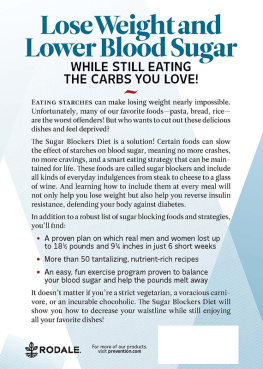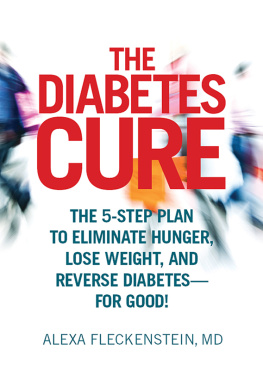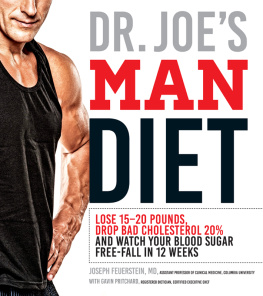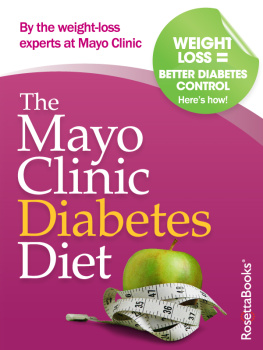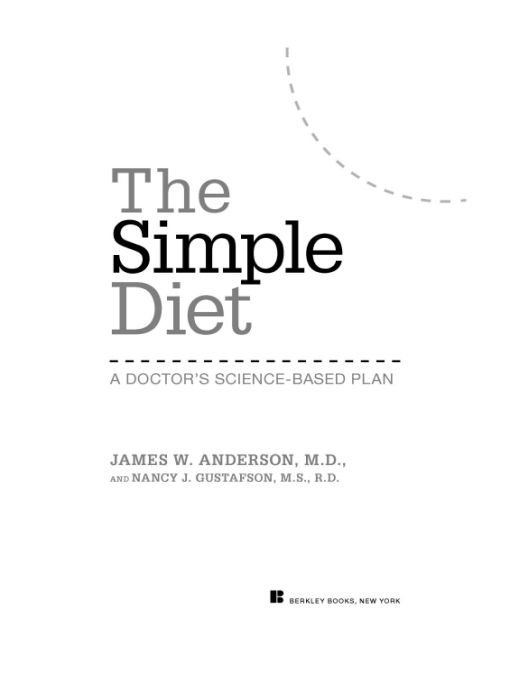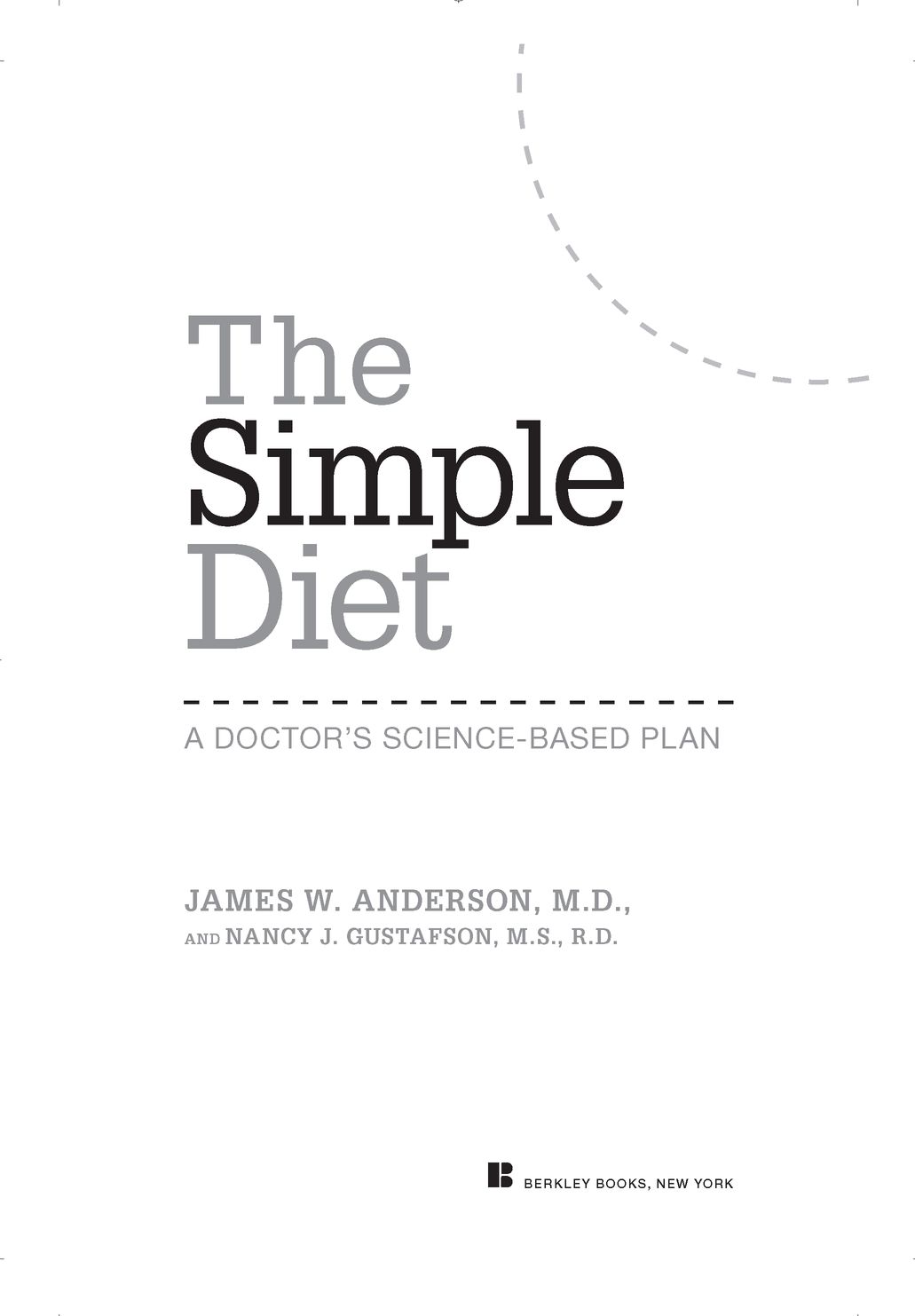Table of Contents
Most Berkley Books are available at special quantity discounts for bulk purchases for sales promotions, premiums, fund-raising, or educational use. Special books, or book cerpts, can also be created to fit specific needs.
For details, write: Special Markets, The Berkley Publishing I Group, 375 Hudson Street, New York, New York 10014.
I dedicate this book to my loving family: Gay, Kathy, Steve, Tom, Anne, Allison, Emily, Caroline, Camille, and Brielle, who continue to inspire me. I also am deeply indebted to my many patients who have encouraged and worked with me as I have asked them to make big changes in their lifestyle.
James W. ANDERSON
To my wonderful husband, children, and children-in-law; for their love, support, and patience.
NANCY J. GUSTAFSON
Acknowledgments
I (James W. Anderson) appreciate the encouragement of Bill Gottlieb and the assistance of Allison Kroll and Lacey Lamb.
The success stories that you read about in this book were all patients I worked with directly. While there are many diet programs and meal replacements available, a number of these participants achieved their results using Health Management Resources (HMR) meal replacements while following the HMR Program. Although the individual stories are based on patients I have treated, the names, ages, occupations, and other details have been modified to protect the identity of these individuals.
We appreciate the diligent and insightful editing of Denise Silvestro, Meredith Giordan, Kate Ritchey, and Jessica McDonnell. The support, editorial help, and encouragement of our agent, Stephany Evans, was invaluable.
Introduction
Meet Your Future
If losing weight were easy, wed all look fabulous and I would have spent most of my research life trying to solve another problem. But losing weight is difficultin fact, for many people, its almost impossiblewhich is why Ive spent most of my career studying how to effectively reverse overweight and the diseases it causes or complicates. Ive been particularly interested in reversing obesity, defined as carrying 30 or more extra pounds.
Medically, obesity puts you at higher risk for heart attack, stroke, high blood pressure, diabetes, cancer, and other life-threatening health conditions. Socially, it stops you from easily participating in everyday activities, whether its romping with your kids or grandkids or fitting comfortably into an airplane seat on your next vacation. Emotionally, it sabotages your self-image. And that includes feeling like a failure every time you blow a diet, which, if youre like most obese people, is over and over again. Failure feels awful. Why even bother starting another diet?
This book tells you that weight-loss failure does not have to be your destiny. Ill tell you about a science-based method for weight-loss success for anyone who needs to lose moderate to large amounts of weight. Yes, losing a lot of weight takes dedication, courage, and effort, but it can be done if you follow the right program.
DiabesityFrom the Lab to the Clinic
Obesity and diabetes are like conjoined twinsthey are almost inseparable. In medical school, I developed a commitment to searching for a cure for diabetes. My first efforts were in the biochemistry laboratory at Northwestern University, then at Mayo Clinic, at the U.S. Army Nutrition Laboratory, at the University of California, San Francisco, and, for the last thirty-eight years, at the University of Kentucky.
In the lab, I explored mechanisms contributing to diabetes, obesity, and blood lipid problems. As I began treating patients with diabetes in the clinic, I quickly learned that 80 percent were obese. This led me to address the obesity issue. As we brought the research ward experience to the clinic, we developed very-low-calorie diets using meal replacements. For my first fifteen years in Kentucky, I treated obese diabetic individuals in the research ward and in the VA Diabetes Clinic with very-low-calorie (under 800 calorie) and low-calorie (8001,200 calorie) diets, and found that effective weight loss could produce a cure for some obese diabetic individuals.
In 1985, I engineered the partnership between Health Management Resources (HMR) and the University of Kentucky. Over the next twenty-five years, as medical director of the HMR Program for Weight Management at the University of Kentucky (hereafter called the program), I worked closely with individuals enrolled in the program, and many of the scientific articles I have published have been related to my experiences with these individuals. Similarly, while all of the case studies presented in this book are composites, they are based on real people I have worked with, and many of them used meal replacement products from the program to achieve their weight loss. My work with the program validated and extended what I had learned from working with obese individuals throughout my career. This book is an outgrowth of these many years of experience in this field of study. This includes over ten thousand obese patients treated at the university or VA clinic and hospital and over five thousand patients treated in the program.
In addition to my academic and professional experiences, I also knew about obesity personally. When I was growing up, my dad stood out in a crowd, not because of his five foot three height, but because of his 235-pound weight; he was severely obese. My mother also was chunky. With my eighty-hour work weeks and extensive national and international travel, I also accumulated weight, and for a short period was on the cusp of obesity at 193 pounds, which is too much for my frame. This heightened my focus on obesity. I dropped down to 155 pounds when I started the program in 1985, but to be frank, I have carried 173 to 187 pounds for most of my adult life. I will also share with you many practical tips and how I dropped 30 pounds while writing this book.
Like my dad, I love to eat, and like my mom, I love to cook. In the early 1980s, I was also researching the health benefits of low-fat, high-fiber diets in addition to my obesity research. As I began developing these diets, I began developing recipes. I became known as Dr. Oat Bran because I helped popularize oat bran. My first oat-bran muffins were like hockey pucks, but I eventually learned how to make tasty muffins that people still eat and brag about because of the effects on their blood cholesterol levels. I have published several hundred recipes and have included a number of shake and entre recipes in this book for you to enjoy.
The Simple Diet is an outgrowth of my research related to obesity, diabetes, high blood fats, and pursuit of the optimal diet for everyone. The goals of this book are to make it easy for you to lose weight safely and effectively, and to develop a lifestyle change in order to manage your weight long-term. I hope to empower you to lose your excess weight and keep it off.
Jan, a charismatic fifty-year-old college dean from Georgia, weighed in at 316 pounds, with a height of five feet seven inches. She had a large frame, and a health-promoting weight for her would be about 160 pounds. At her initial evaluation, she had high blood pressure, arthritis, high blood cholesterol, and varicose veins.
This charming, talkative woman with blue-gray eyes and blond hair had taken a leave of absence for one academic year and was in Kentucky to be with and care for her mother, who had terminal cancer. When she heard about the program, she recognized an opportunity to do something for herself as well. She jumped into the program with both feet and followed it religiously, using meal replacements, fruits, and vegetables while gradually increasing her physical activity.


